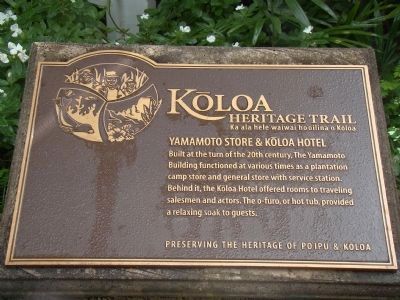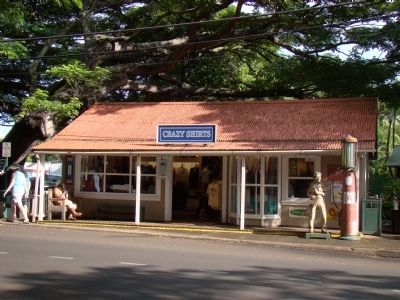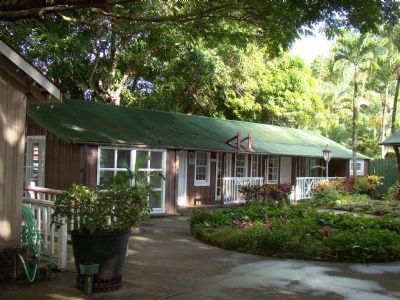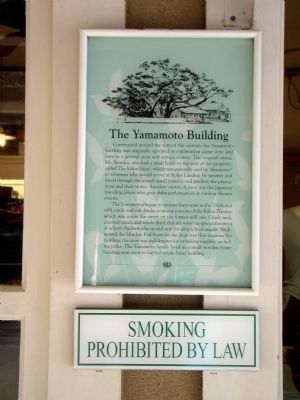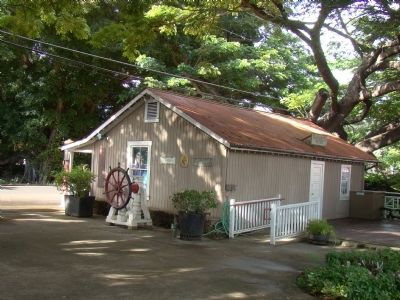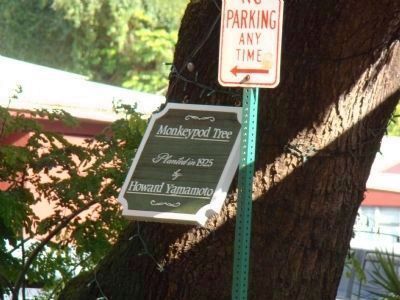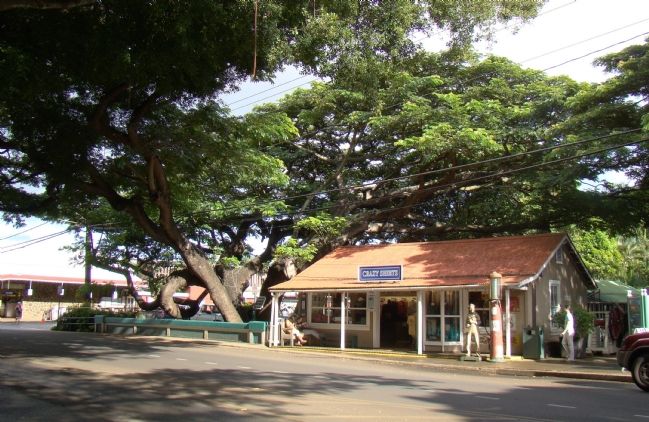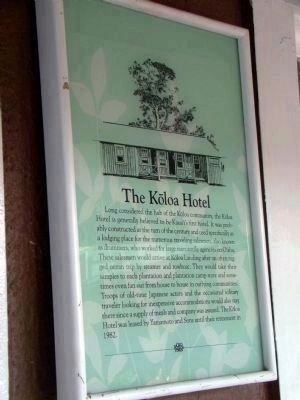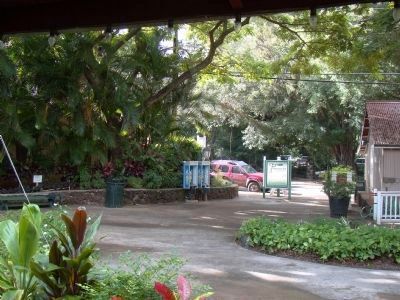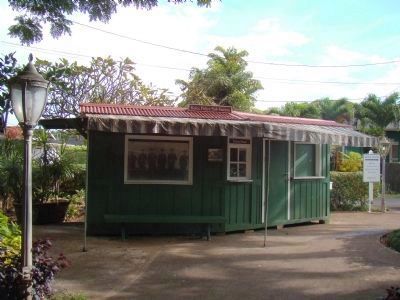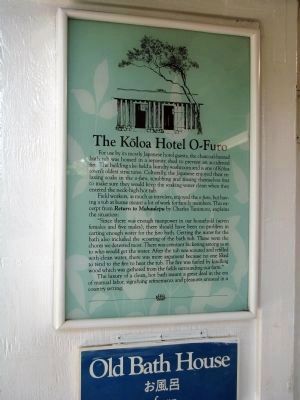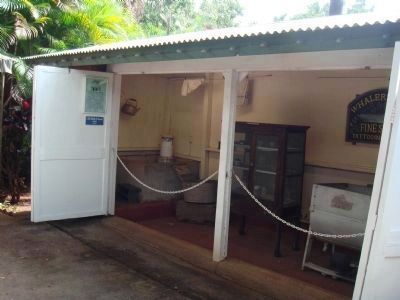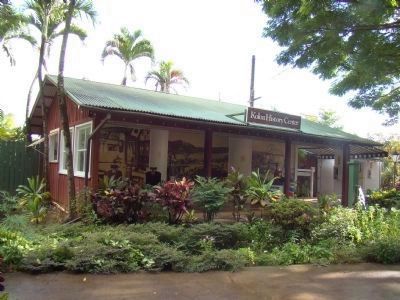Koloa in Kauai County, Hawaii — Hawaiian Island Archipelago (Pacific Ocean)
Yamamoto Store & Kōloa Hotel
Kōloa Heritage Trail — Ka Ala Hele Waiwai Ho‘olina o Kōloa
— Preserving the Heritage of Po‘ipū & Kōloa —
Erected by Po‘ipū Beach Foundation. (Marker Number 13.)
Topics. This historical marker is listed in this topic list: Notable Buildings.
Location. 21° 54.217′ N, 159° 27.95′ W. Marker is in Koloa, Hawaii, in Kauai County. Marker is on Koloa Road (Hawaii Route 530) west of Maluhia Road (Hawaii Route 520), on the right when traveling south. Touch for map. Marker is in this post office area: Koloa HI 96756, United States of America. Touch for directions.
Other nearby markers. At least 8 other markers are within 2 miles of this marker, measured as the crow flies. Koloa, Birthplace of the Hawaiian Sugar Industry (about 300 feet away, measured in a direct line); Kōloa Missionary Church (approx. 0.2 miles away); Kōloa Jodo Mission (approx. ¼ mile away); Prince Kūhiō Birthplace & Park (approx. 1.6 miles away); Hanaka‘ape Bay & Kōloa Landing (approx. 1.7 miles away); Hapa Road (approx. 1.8 miles away); Pu‘uwanawana Volcanic Cone (approx. 1.9 miles away); Pā‘ū a Laka (Moir Gardens) (approx. 1.9 miles away). Touch for a list and map of all markers in Koloa.
Related marker. Click here for another marker that is related to this marker. It is the first of the Kōloa Heritage Trail markers, and has a link to a list of all Kōloa Heritage Trail markers.
Additional commentary.
1. The Yamamoto Building
(transcription of interpretative marker in Photo 4.)
Constructed around the turn of the century, the Yamamoto building was originally operated as a plantation camp store and later as a general store and service station. The original owner, Mr. Yamaka, also had a small hotel to the rear of the property—called The Kōloa Hotel—which was generally used by “drummers” or salesmen who would arrive at Koloa Landing by steamer and travel through the island’s small towns to sell goods to the plantations and their stores. Another variety of guest was the Japanese traveling player who gave shibai performances at outdoor theater events.
The Yamamotos began to operate their store in the 1920s and sold candy and soft drinks to movie patrons of the Kōloa Theater which was across the street on the former mill site. Crack seed, coconut candy and whole dried abalone were the special favorites of school children who would stop for after school snacks. Nicknamed the Monkey Pod Store for the large tree that shadows the building, the store was well-known for its fishing supplies, including poles. The Yamamoto family lived in a small wooden frame building next door to the Salvation Army building.
— Submitted October 26, 2008.
2. The Kōloa Hotel
(transcription of interpretative marker in Photo 8.)
Long considered the hub of the Kōloa community, the Kōloa Hotel is generally believed to be Kauai‘i’s first hotel. It was probably constructed at the turn of the century and used specifically as a lodging place for the numerous traveling salesmen, also known as drummers, who worked for large mercantile agencies on O‘ahu. These salesmen would arrive at Kōloa Landing after an often rugged ocean trip by steamer and rowboat. The would take their samples to each plantation camp store and sometimes even fan out from house to house in outlying communities. Troops of old-time Japanese actors and the occasional solitary traveler looking for inexpensive accommodations would also stay there since a supply of meals and company was assured. The Kōloa Hotel was leased by Yamamoto and Sons until their retirement in 1982.
3. The Koloa Hotel O-Furo
(transcription of interpretative marker in Photo 11.)
For use by its mostly Japanese hotel guests, the charcoal-heated bath tub was housed in a separate shed to prevent an accidental fire. The building also held a laundry washroom and is one of Kōloa town’s oldest structures. Culturally, the Japanese enjoyed their relaxing soaks in the o-furo, scrubbing and rinsing themselves first to make sure they would keep the soaking water clean when they entered the neck-high hot tub.
Field workers, as much as travelers, enjoyed the o-furo, but having a tub at home meant a lot of work for family members. This excerpt from Return to Mahaulepu by Charles Tanimoto, explains the situation:
“Since there was enough manpower in our household (seven females and five males), there should have been no problem in carting enough water for the furo bath. Getting the water for the bath also included the scouring of the bath tub. These were the chores we detested most. There was constant bickering among us as to who would get the water. After the tub was scoured and refilled with clean water, there was more argument because no one liked to tend to the fire to heat the tub. The fire was fueled by kindling wood which was gathered from the fields surrounding our farm.”
The luxury of a clean, hot bath meant a great deal in the era of manual labor, signifying refinements and pleasures unusual in a country setting.
— Submitted October 28, 2008.
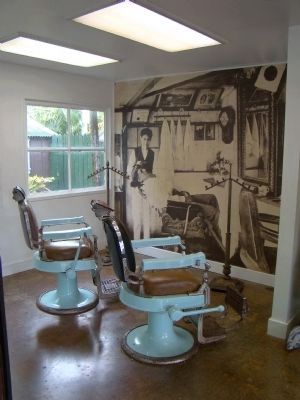
Photographed By J. J. Prats, October 13, 2008
14. Barber Shop (1910)
The interpretive sign reads “Tadao Kawamoto, the famous Barber of Koloa, probably served as an apprentice in a shop much like the one pictured here. Haircuts were 25 cents and a shave cost 15 cents. Photograph [reproduced on wall] courtesy of the Bishop Museum.”
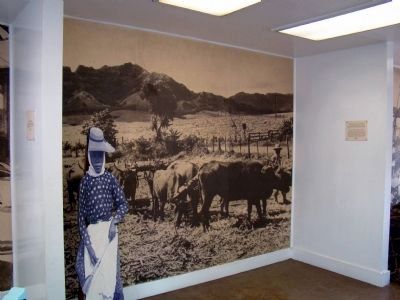
Photographed By J. J. Prats, October 13, 2008
15. Koloa Plantation (Circa early 1900s) / Japanese Woman Plantation Worker
The interpretative sign reads “Oxen were used to plow and drag the sugar fields. Koloa Plantation was the first successful sugar plantation and was used as a blueprint for all other plantations in Hawaii which would follow.” And “Waves of immigration changed the face of the worker in the sugar fields. The women often were assigned the less physical work of stripping the dried sugar cane leaves from the stalks (Holehole is Hawaiian for dried sugar cane leaves). However, a typical day for a woman began before 4:30 am as she prepared breakfast and the lunches to be taken to work and then worked in the fields from 6 am to 4:30 pm. Photographs courtesy of Kauai Museum.”
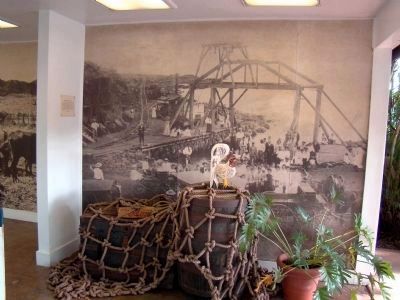
Photographed By J. J. Prats, October 13, 2008
16. Koloa Landing (Circa 1910s)
The interpretative sign reads “Located at the mouth of Waikomo Stream, Koloa Landing was the third largest whaling port on Hawaii, along with Lahaina, Maui, and Honolulu, Oahu. The Landing boasted a customs office during the monarchy period, serving as a port of entry for foreign goods. Ships put in for firewood beef, port, and native produce. In the 1850s Koloa supplied California with sweet potatoes and oranges grown by Hawaiian farmers. Sugar from Koloa Plantation was shipped fro Koloa Landing until 1912. Photograph [reproduced on wall] courtesy of Tom Kurisu.”
Credits. This page was last revised on June 16, 2016. It was originally submitted on October 26, 2008, by J. J. Prats of Powell, Ohio. This page has been viewed 3,270 times since then and 64 times this year. Photos: 1, 2, 3, 4, 5, 6, 7, 8, 9, 10. submitted on October 26, 2008, by J. J. Prats of Powell, Ohio. 11, 12. submitted on October 27, 2008, by J. J. Prats of Powell, Ohio. 13, 14, 15, 16. submitted on October 26, 2008, by J. J. Prats of Powell, Ohio.
